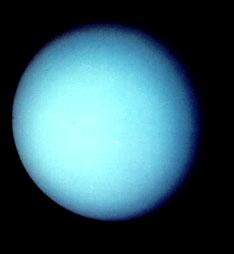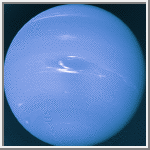THE OUTER PLANETS
THE DISCOVERY
In 1781 William Herschel while viewing the sky from his garden in Bath, England recognized that an object in the constellation of Gemini was moving against the background of stars. At first he thought he was looking at a new comet but upon further investigation realized that he was looking at a new planet.
Herschel named his discovery 'the Georgian planet' after his patron George III. Other names proposed included Herschel, Uranus or Hypercronius. Eventually Uranus became the universally accepted name.
 By the early 19th century it became evident that the orbit of Uranus did not follow Newton's law of Gravitation. Many astronomers began to question whether Newton's theory of gravitation applied to an object so far from the sun. However two astronomers, John Couch Adams in England and Urbain Le Verrier in France, both independently came up with the theory that the orbit of Uranus had been disturbed by a more distant planet.
By the early 19th century it became evident that the orbit of Uranus did not follow Newton's law of Gravitation. Many astronomers began to question whether Newton's theory of gravitation applied to an object so far from the sun. However two astronomers, John Couch Adams in England and Urbain Le Verrier in France, both independently came up with the theory that the orbit of Uranus had been disturbed by a more distant planet.
Working to Le Verrier's calculations, astronomers at the Berlin observatory were able to identify this planet.
They had discovered the eighth planet of the solar system, Neptune.
 After the discovery of Neptune, astronomers started to look further into the depths of the solar system for a ninth planet.
After the discovery of Neptune, astronomers started to look further into the depths of the solar system for a ninth planet.
In 1930, an American astronomer discovered the last of the known worlds of our solar system, Pluto.

Pluto is named after the god of the underworld, an apt name for a planet that orbits 5900 million kilometres from the sun.
THE THREE NEW WORLDS
Uranus is a bluish green gas giant. It takes 84 years to orbit the sun. Unlike all the other planets Uranus spins on its side. This means that the northern hemisphere of the planet sees the sun continually spinning round in the sky for over 40 years only to be plunged into darkness for 40 more. For the southern hemisphere the seasons are reversed.
| Uranus Statistics
|
|---|
|
|
|---|
| Equatorial radius (km) | 25,559
|
|---|
| Mean distance from the Sun (km) | 2,870,990,000
|
|---|
| Mean distance from the Sun (Earth = 1) | 19.1914
|
|---|
| Rotational period (hours) | -17.9
|
|---|
| Orbital period (years) | 84.01
|
|---|
| Mean cloud temperature | -193°C
|
|---|
| Atmospheric pressure (bars) | 1.2
|
|---|
Atmospheric compositionHydrogenHeliumMethane
83%
15%
2%
| |
|---|
Neptune is a blue (gas giant) planet of similar size to Uranus.
Its colour comes from the methane in its atmosphere. Methane absorbs the longer visible wavelengths (red and yellow) so the reflected sunlight appears blue.
Neptune has a very active atmosphere with high wind speeds that move around the planet faster than it rotates.
| Neptune Statistics
|
|---|
|
|
|---|
| Equatorial radius (km) | 24,746
|
|---|
| Mean distance from the Sun (km) | 4,504,300,000
|
|---|
| Mean distance from the Sun (Earth = 1) | 30.0611
|
|---|
| Rotational period (hours) | 16.11
|
|---|
| Orbital period (years) | 164.79
|
|---|
| Mean cloud temperature | -193 to -153°C
|
|---|
| Atmospheric pressure (bars) | 1-3
|
|---|
Atmospheric compositionHydrogenHeliumMethane
85%
13%
2%
| |
|---|
Pluto is a bit of a puzzle. All the inner planets are small rocky worlds. The outer planets are gas giants. However Pluto, the furthest of the planets from the sun is a small icy rock of a planet. It is almost a double planet system because it is orbited by a large moon, Charon. The discovery of the moon Charon weakened the theory that Pluto is an escaped moon of Neptune. It is now thought that Pluto came from a region of space debris left after the forming of the solar system called the Kuiper Belt.
| Pluto Statistics
|
|---|
|
|
|---|
| Equatorial radius (km) | 1,160
|
|---|
| Mean distance from the Sun (km) | 5,913,520,000
|
|---|
| Mean distance from the Sun (Earth = 1)) | 39.5294
|
|---|
| Rotational period (days) | -6.3872
|
|---|
| Orbital period (years) | 248.54
|
|---|
Atmospheric compositionMethaneNitrogen| 0.3
| |
|---|
OBSERVING THE PLANETS
Arm yourself with a finder chart (from a computer star chart or astronomy magazine) and a pair of binoculars and hopefully you will be able to find Uranus edging it's way across the background of stars. For beginners this is quite a difficult task because the planet is usually not bright enough to be seen with the unaided eye.
Neptune is an even harder target to find than Uranus. Although it is roughly the same size as Uranus, Neptune is a lot further away and therefore appears a lot dimmer and smaller to us.
Pluto is only visible in the largest of telescopes and is beyond the reach of most amateur astronomers.

 By the early 19th century it became evident that the orbit of Uranus did not follow Newton's law of Gravitation. Many astronomers began to question whether Newton's theory of gravitation applied to an object so far from the sun. However two astronomers, John Couch Adams in England and Urbain Le Verrier in France, both independently came up with the theory that the orbit of Uranus had been disturbed by a more distant planet.
By the early 19th century it became evident that the orbit of Uranus did not follow Newton's law of Gravitation. Many astronomers began to question whether Newton's theory of gravitation applied to an object so far from the sun. However two astronomers, John Couch Adams in England and Urbain Le Verrier in France, both independently came up with the theory that the orbit of Uranus had been disturbed by a more distant planet.
 After the discovery of Neptune, astronomers started to look further into the depths of the solar system for a ninth planet.
After the discovery of Neptune, astronomers started to look further into the depths of the solar system for a ninth planet.

